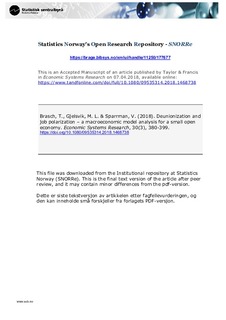| dc.contributor.author | Brasch, Thomas von | |
| dc.contributor.author | Gjelsvik, Marit Linnea | |
| dc.contributor.author | Sparrman, Victoria | |
| dc.date.accessioned | 2019-01-14T17:40:51Z | |
| dc.date.available | 2019-01-14T17:40:51Z | |
| dc.date.issued | 2018-05-07 | |
| dc.identifier.citation | Thomas von Brasch, Marit Linnea Gjelsvik & Victoria Sparrman (2018) Deunionization and job polarization – a macroeconomic model analysis for a small open economy, Economic Systems Research, 30:3, 380-399, DOI: 10.1080/09535314.2018.1468738 | nb_NO |
| dc.identifier.issn | 1469-5758 | |
| dc.identifier.uri | http://hdl.handle.net/11250/2580568 | |
| dc.description.abstract | Declining unionization rates and job polarization are two important labor market developments of recent decades. A large body of literature has analyzed these phenomena separately, but little has been done to see whether there is a link between them. We employ a macroeconomic model for a small open economy with a large input–output core to analyze how deunionization may cause job polarization. Our analysis shows that medium-skilled workers are negatively affected by deunionization, mainly as a result of the heterogeneity of the elasticities of substitution between different types of labor. While the elasticities of substitution between high- and medium-skilled labor are relatively low, the elasticities of substitution between medium- and low-skilled are relatively high. As a result, when deunionization leads to increased wage dispersion, we find that demand for low-skilled increases at the expense of medium-skilled labor, thus yielding a more polarized labor market. | nb_NO |
| dc.language.iso | eng | nb_NO |
| dc.publisher | Taylor & Francis | nb_NO |
| dc.subject | Inequality | nb_NO |
| dc.subject | Wage differentials | nb_NO |
| dc.subject | Technological change | nb_NO |
| dc.subject | Trade union | nb_NO |
| dc.title | Deunionization and job polarization – a macroeconomic model analysis for a small open economy | nb_NO |
| dc.type | Journal article | nb_NO |
| dc.type | Peer reviewed | nb_NO |
| dc.description.version | acceptedVersion | nb_NO |
| dc.rights.holder | Taylor & Francis. | nb_NO |
| dc.subject.nsi | VDP::Samfunnsvitenskap: 200::Økonomi: 210 | nb_NO |
| dc.source.pagenumber | 380-399 | nb_NO |
| dc.source.volume | 30 | nb_NO |
| dc.source.journal | Economic Systems Research | nb_NO |
| dc.source.issue | 3 | nb_NO |
| dc.identifier.doi | https://doi.org/10.1080/09535314.2018.1468738 | |
| dc.relation.project | This paper has been financed by the Ministry of Education and Research, Ministry of Health and Care Services, Ministry of Labor and Social Affairs and Ministry of Trade, Industries and Fisheries. We are also grateful for funding provided by the Research Council of Norway | nb_NO |
